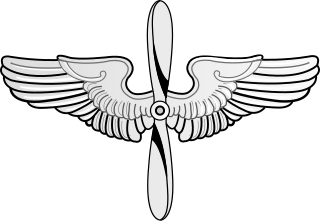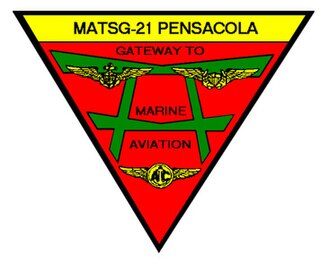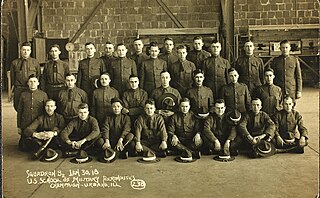
The Army Air Corps (AAC) is the aviation arm of the British Army, first formed in 1942 during the Second World War by grouping the various airborne units of the British Army. Today, there are eight regiments of the AAC, as well as two independent flights and two independent squadrons deployed in support of British Army operations around the world. Regiments and flights are located in the United Kingdom, Kenya, and Canada. Some AAC squadrons provide the air assault elements of 16 Air Assault Brigade Combat Team, through Joint Aviation Command.

The United States Army Air Service (USAAS) was the aerial warfare service component of the United States Army between 1918 and 1926 and a forerunner of the United States Air Force. It was established as an independent but temporary branch of the U.S. War Department during World War I by two executive orders of President Woodrow Wilson: on May 24, 1918, replacing the Aviation Section, Signal Corps as the nation's air force; and March 19, 1919, establishing a military Director of Air Service to control all aviation activities. Its life was extended for another year in July 1919, during which time Congress passed the legislation necessary to make it a permanent establishment. The National Defense Act of 1920 assigned the Air Service the status of "combatant arm of the line" of the United States Army with a major general in command.

Number 15 Squadron, sometimes written as No. XV Squadron, was a squadron of the Royal Air Force. It most recently operated the Panavia Tornado GR4 from RAF Lossiemouth as No. XV (Reserve) Squadron. It was the RAF's Operational Conversion Unit for the Tornado GR4 which taught pilots and Weapon Systems Officers (WSO) how to fly the aircraft and what tactics to use to best exploit the performance of their aircraft and its weapons.

A naval aviator is a commissioned officer or warrant officer qualified as a crewed aircraft pilot in the United States Navy or United States Marine Corps. United States Coast Guard crewed aircraft pilots are officially designated as "Coast Guard aviators", although they complete the same undergraduate flight training as Navy and Marine Corps crewed aircraft pilots, and are awarded the same aviation breast insignia.
Bill Gunston was a British aviation and military author. He flew with Britain's Royal Air Force from 1945 to 1948, and after pilot training became a flying instructor. He spent most of his adult life doing research and writing on aircraft and aviation. He was the author of over 350 books and articles. His work included many books published by Salamander Books.

Tail codes are markings usually on the vertical stabilizer of U.S. military aircraft that help identify the aircraft's unit and/or base assignment. This is not the same as the serial number, bureau number, or aircraft registration which provide unique aircraft identification.

The Order of Lenin Leningrad Military District is a military district of the Armed Forces of the Russian Federation. The district was awarded the Order of Lenin in 1968. In 2010, it was merged with the Moscow Military District, the Northern Fleet and the Baltic Fleet to form the new Western Military District. In December 2022, Defense Minister Sergey Shoigu proposed to reestablish it along with the Moscow Military District, a decision confirmed in June 2023 by Deputy Chief of the General Staff Yevgeny Burdinsky. On December 17, 2023 Vladimir Putin announced plans to recreate the Leningrad Military District as a reaction to Finland joining NATO. The district was formally reconstituted on 26 February 2024 by a Presidential Decree №141, transfering the Northern Fleet under its command.

U.S. Air Force aeronautical ratings are military aviation skill standards established and awarded by the United States Air Force for commissioned officers participating in "regular and frequent flight", either aerially or in space, in performance of their duties. USAF aeronautical badges, commonly referred to as "wings" from their shape and their historical legacy, are awarded by the Air Force in recognition of degrees of achievement and experience. Officers earning these badges and maintaining their requirements are classified as rated officers and receive additional pay and allowances.

Marine Aviation and Training Support Group 21 (MATSG-21) is a United States Marine Corps aviation training group that was originally established in 1922 as the 2nd Aviation Group. During World War II the unit was known as Marine Aircraft Group 21 (MAG-21). Squadrons from MAG-21 fought in many of the opening battles of the war to include the Battle of Wake Island, Battle of Midway and as part of the Cactus Air Force during the Battle of Guadalcanal. The group was deactivated following the end of the war and was not reactivated until 2000 when the Marine Aviation Detachment at Naval Air Station Pensacola, Florida was renamed MATSG-21. The core of the MATSG personnel is derived from 175 officer instructors and 550 student naval aviators/naval flight officers.

Air Enthusiast was a British, bi-monthly, aviation magazine, published by the Key Publishing group. Initially begun in 1974 as Air Enthusiast Quarterly, the magazine was conceived as a historical adjunct to Air International magazine. Air International was involved with current aviation topics and the Quarterly concerned itself with historical matters.

The United States Marine Corps Aviation (USMCA) is the aircraft arm of the United States Marine Corps. Aviation units within the Marine Corps are assigned to support the Marine Air-Ground Task Force, as the aviation combat element, by providing six functions: assault support, antiair warfare, close air support, electronic warfare, control of aircraft and missiles, and aerial reconnaissance. The Corps operates rotary-wing, tiltrotor, and fixed-wing aircraft mainly to provide transport and close air support to its ground forces. Other aircraft types are also used in a variety of support and special-purpose roles. All Marine Corps aviation falls under the influence of the Deputy Commandant for Aviation, whose job is to advise the Commandant of the Marine Corps in all matters relating to aviation, especially acquisition of new assets, conversions of current aircraft, maintenance, operation, and command.
Air-Britain, traditionally sub-titled 'The International Association of Aviation Enthusiasts', is a non-profit aviation society founded in July 1948. As from 2015, it is constituted as a British charitable trust and book publisher.

The United States Army Air Forces was the major land-based aerial warfare service component of the United States Army and de facto aerial warfare service branch of the United States during and immediately after World War II (1941–1947). It was created on 20 June 1941 as successor to the previous United States Army Air Corps and is the direct predecessor of the United States Air Force, today one of the six armed forces of the United States. The AAF was a component of the United States Army, which on 2 March 1942 was divided functionally by executive order into three autonomous forces: the Army Ground Forces, the United States Army Services of Supply, and the Army Air Forces. Each of these forces had a commanding general who reported directly to the Army Chief of Staff.

The United States Army Air Corps (USAAC) was the aerial warfare service component of the United States Army between 1926 and 1941. After World War I, as early aviation became an increasingly important part of modern warfare, a philosophical rift developed between more traditional ground-based army personnel and those who felt that aircraft were being underutilized and that air operations were being stifled for political reasons unrelated to their effectiveness. The USAAC was renamed from the earlier United States Army Air Service on 2 July 1926, and was part of the larger United States Army. The Air Corps became the United States Army Air Forces (USAAF) on 20 June 1941, giving it greater autonomy from the Army's middle-level command structure. During World War II, although not an administrative echelon, the Air Corps (AC) remained as one of the combat arms of the Army until 1947, when it was legally abolished by legislation establishing the Department of the Air Force.

The Flying/Aviation Cadet Pilot Training Program was originally created by the U.S. Army to train its pilots. Originally created in 1907 by the U.S. Army Signal Corps, it expanded as the Army's air assets increased.
James Hay Stevens was an aviation journalist, editor of Aircraft Engineering (1945-1957) magazine, illustrator and pilot. He created the Skybirds range of 1:72 scale model aircraft kits produced by A. J. Holladay & Co., the same scale later being adopted by Airfix. Between 1938-1939 he contributed articles and illustrations to Air Stories magazine, and between 1959–1967, he contributed articles to the newspaper The Times.

Air Vice-Marshal Sir Charles Warburton Meredith was a South African air force pilot, and Air Officer Commanding of the Rhodesian Air Training Group during the Second World War.

The Assistant Chief of the Naval Staff (Aviation, Amphibious Capability & Carriers) formerly the Assistant Chief of the Naval Staff (Aviation and Carrier Strike) is a senior Royal Navy appointment responsible for naval aviation. The post is also the successor to the Royal Navy's Flag Officer for naval aviation in the British Isles, established since 1939.














